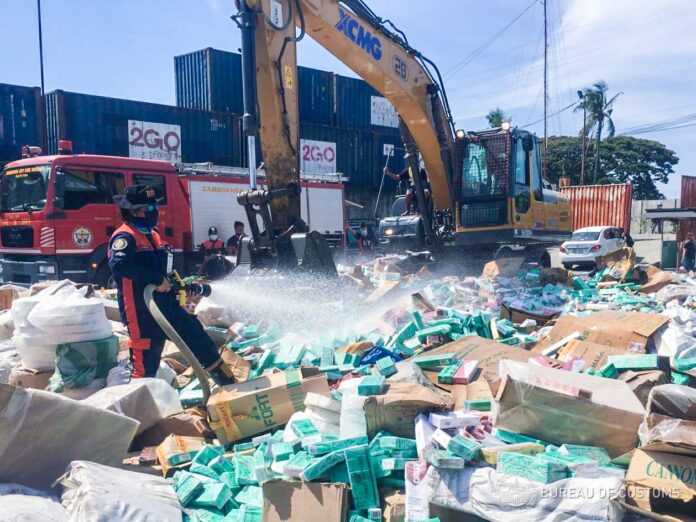
-
Customs Memorandum Order 24-2021 provides new rules on the disposition of forfeited and abandoned goods through condemnation
-
It provides a mechanism for expediting disposition and release of shipments for condemnation
-
The order is meant to help ports decongest overstaying containers
-
CMO 24-2021 implements provisions of Customs Administrative Order No. 03-2020, which provides rules for all modes of disposition of seized, abandoned and forfeited goods
The Bureau of Customs (BOC) has released new rules relating to the disposition of forfeited and abandoned goods through condemnation.
Customs Memorandum Order No. 24-2021, signed by Customs Commissioner Rey Leonardo Guerrero on July 29, provides a mechanism for expediting disposition and release of shipments for condemnation and assisting ports to decongest overstaying containers. The order takes effect 15 days after its posting on the BOC website.
CMO 24-2021 implements provisions of Customs Administrative Order No. 03-2020, which contains new rules and procedures for all modes of disposition of seized, abandoned, and forfeited goods.
READ: BOC simplifies rules for disposing seized, abandoned and forfeited goods
Condemnation or destruction is a mode of disposition for shipments that are considered injurious to public health or prohibited under the Customs Modernization and Tariff Act (CMTA).
Goods subject to condemnation are the following:
- Restricted goods highly dangerous to be kept or handled
- Goods absolutely prohibited unless the mode of disposition is specifically provided by the CMTA
- Goods prohibited by law to be released, unless the mode of disposition is specifically provided by the CMTA or by regulation
- Goods with no commercial value
- Goods injurious to public health
Modes of condemnation include rendering, crushing, thermal decomposition, breaking, shedding, pyrolysis, dumping if application and deemed as the most practicable, or any other method deemed appropriate by the Condemnation Committee and approved by the district collector.
Under CMO 24-2021, the collection district should ensure the chosen mode of condemnation complies with all environmental laws, rules, and regulations.
The representative of the Association of International Shipping Lines (AISL) or other organizations/associations of shipping lines may be present during the deliberations on awarding of contract for the condemnation of containerized cargoes to accredited service contractors.
CMO 24-2021 also provides procedures in accrediting service contractors for the condemnation of goods in line with the Ease of Doing Business and Efficient Government Service Delivery Act of 2018.
A Condemnation Committee headed by the Auction and Cargo Disposal Division (ACDD) was created to approve/disapprove the recommendation of the ACDD for accreditation of a service contractor.
The Condemnation Committee is responsible for ensuring all concerned offices are notified three days prior to the time, date, and schedule of the condemnation.
For containers set for transfer from the terminal to the condemnation facility, the ACDD should, within 24 hours of receiving the order of condemnation, furnish the concerned shipping line or AISL member via email or other electronic means the approved order of condemnation and supporting documents for the issuance of the required container release order (CRO) covering the condemned shipment.
The shipping line has 72 hours to issue the CRO in favor of the nominated service contractor. Barring such, the district collect should write to the terminal operator to issue the corresponding gate pass to allow transfer of the container to the condemnation facility.
If the condemned goods are loaded in containers whose owners are unknown or which are owned by shipping lines no longer operating in the Philippines and a CRO can no longer be issue, the district collector should directly inform the terminal operator and request the corresponding gate pass even without the prerequisite CRO.
The Container and Cargo Control Division (CCCD) should ensure empty containers stored at their condemnation facility are still intact for final disposition by the port. It is also the CCCD’s responsibility to ensure shipping lines are given notice to claim their respective container within five days of receiving the notice to claim and full payment of the amount in relation to the services rendered in the condemnation of the cargo.
Under CMO 24-2021, the shipping line and service contractor may enter into an internal arrangement on how to return the empty container from the contractor’s facility to the shipping line’s depot.
Emptied containers which have not been pulled out by shipping lines five days after receipt of the notice to claim will be deemed abandoned and dealt with by BOC in keeping with the rules on abandonment and disposal of forfeited shipments.
All collection districts were directed to closely coordinate with shipping lines and terminal operators to expedite disposition and pullout of goods for condemnation and ensure effective implementation of CMO 24-2021. – Roumina Pablo




